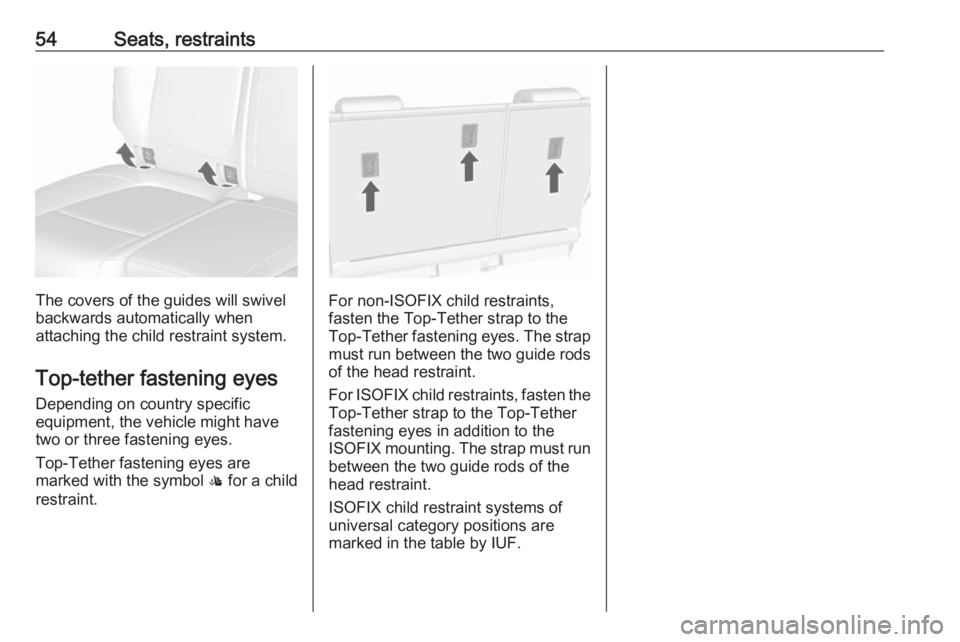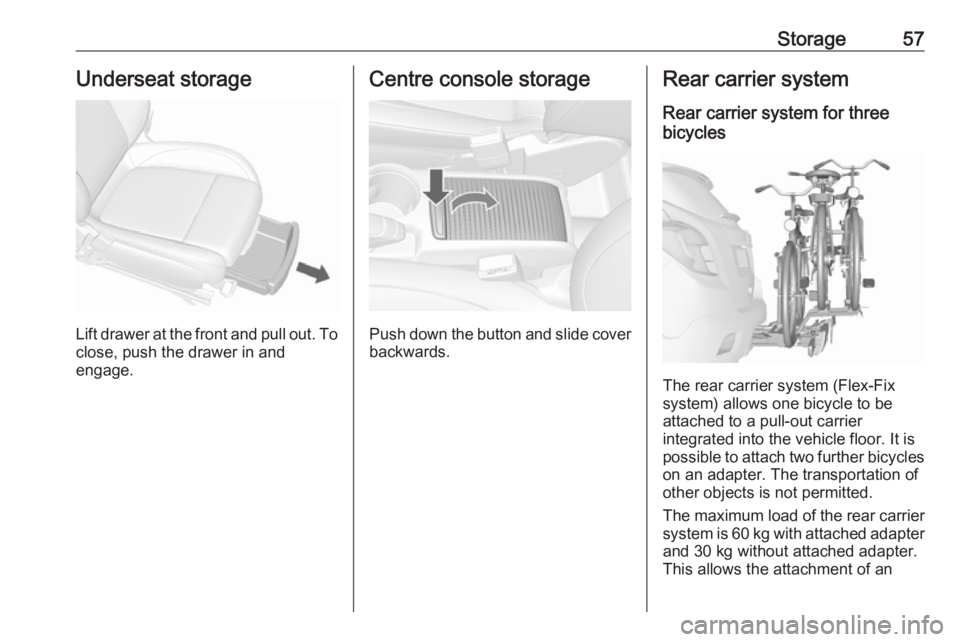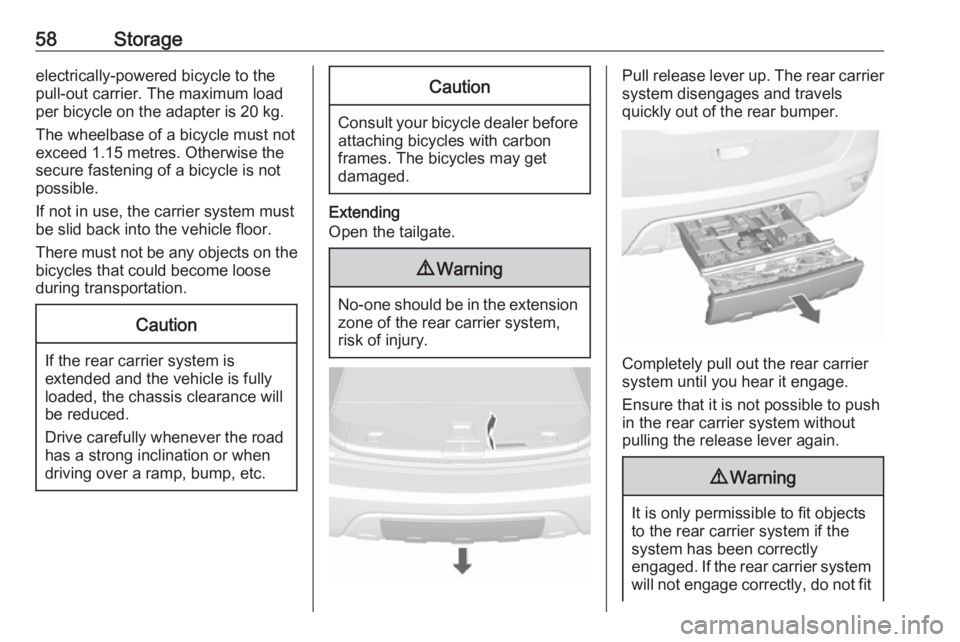OPEL MOKKA 2017 Workshop Manual
Manufacturer: OPEL, Model Year: 2017, Model line: MOKKA, Model: OPEL MOKKA 2017Pages: 233, PDF Size: 6.69 MB
Page 51 of 233

Seats, restraints49Child restraints
Child restraint systems
We recommend the Opel child
restraint system which is tailored
specifically to the vehicle.
When a child restraint system is being used, pay attention to the following
usage and installation instructions
and also those supplied with the child
restraint system.
Always comply with local or national
regulations. In some countries, the
use of child restraint systems is
forbidden on certain seats.9 Warning
When using a child restraint
system on the front passenger
seat, the airbag systems for the
front passenger seat must be
deactivated; if not, the triggering of the airbags poses a risk of fatal
injury to the child.
This is especially the case if rear-
facing child restraint systems are
used on the front passenger seat.
Airbag deactivation 3 48.
Airbag label 3 43.
Selecting the right system The rear seats are the most
convenient location to fasten a child
restraint system.
Children should travel facing
rearwards in the vehicle as long as
possible. This ensures that the child's backbone, which is still very weak, is
under less strain in the event of an
accident.
Suitable are restraint systems that
comply with valid UN ECE
regulations. Check local laws and
regulations for mandatory use of child restraint systems.
Ensure that the child restraint system
to be installed is compatible with the
vehicle type.
Ensure that the mounting location of
the child restraint system within the
vehicle is correct, see following
tables.
Allow children to enter and exit the
vehicle only on the side facing away
from the traffic.When the child restraint system is not in use, secure the seat with a seat beltor remove it from the vehicle.
Note
Do not affix anything on the child
restraint systems and do not cover
them with any other materials.
A child restraint system which has
been subjected to stress in an
accident must be replaced.
Page 52 of 233

50Seats, restraintsChild restraint installation locations
Permissible options for fitting a child restraint system
Weight and age class
On front passenger seat
On rear outboard seatsOn rear centre seat
activated airbagdeactivated airbagGroup 0: up to 10 kg
or approx. 10 monthsXU 1U2U2Group 0+: up to 13 kg
or approx. 2 yearsXU 1U2U2Group I: 9 to 18 kg
or approx. 8 months to 4 yearsXU 1U 2U2Group II: 15 to 25 kg
or approx. 3 to 7 yearsXXU 2U2Group III: 22 to 36 kg
or approx. 6 to 12 yearsXXU 2U21:if the child restraint system is being secured using a three-point seat belt, move seat height adjustment to uppermost
position and ensure that vehicle seat belt runs forwards from the upper anchorage point. Adjust seat backrest
inclination as far as necessary to a vertical position to ensure that the belt is tight on the buckle side.2:move the head restraint to uppermost position. If it interferes with the proper installation of the child restraint system, remove the head restraint 3 35.U:universal suitability in conjunction with three-point seat belt.X:no child restraint system permitted in this weight class.
Page 53 of 233

Seats, restraints51Permissible options for fitting an ISOFIX child restraint systemWeight classSize classFixtureOn front passenger seatOn rear outboard seatsOn rear centre seatGroup 0: up to 10 kgEISO/R1XIL1XGroup 0+: up to 13 kgEISO/R1XIL 1XDISO/R2XIL1XCISO/R3XIL1XGroup I: 9 to 18 kgDISO/R2XIL1XCISO/R3XIL1XBISO/F2XIL, IUFXB1ISO/F2XXIL, IUFXAISO/F3XIL, IUFXGroup II: 15 to 25 kg
or approx. 3 to 7 yearsXILXGroup III: 22 to 36 kg
or approx. 6 to 12 yearsXILX
Page 54 of 233

52Seats, restraints1:move front passenger seat to the foremost position or adjust front seat backrest inclination as far as necessary to
a vertical position to ensure that there is no interference between child restraint system and front seat backrest.IL:suitable for particular ISOFIX restraint systems of the "specific-vehicle", "restricted" or "semi-universal" categories.
The ISOFIX restraint system must be approved for the specific vehicle type.IUF:suitable for ISOFIX forward-facing child restraint systems of universal category approved for use in this weight class.X:no ISOFIX child restraint system approved in this weight class.
ISOFIX size class and seat device
A – ISO/F3:forward-facing child restraint system for children of maximum size in the weight class 9 to 18 kgB – ISO/F2:forward-facing child restraint system for smaller children in the weight class 9 to 18 kgB1 – ISO/F2X:forward-facing child restraint system for smaller children in the weight class 9 to 18 kgC – ISO/R3:rear-facing child restraint system for children of maximum size in the weight class up to 18 kgD – ISO/R2:rear-facing child restraint system for smaller children in the weight class up to 18 kgE – ISO/R1:rear-facing child restraint system for young children in the weight class up to 13 kg
Page 55 of 233

Seats, restraints53ISOFIX child restraintsystems
Installation of ISOFIX child
restraint systems without
permanent guide
Fasten vehicle-approved ISOFIX
child restraint systems to the ISOFIX
mounting brackets. Specific vehicle
ISOFIX child restraint system
positions are marked in the table by
IL.
ISOFIX mounting brackets are
indicated by a label on the backrest.
Installation of ISOFIX child
restraint systems with permanent
guide
The vehicle might be equipped with
guides in front of the mounting
brackets to support the installation of the child restraint system.
Page 56 of 233

54Seats, restraints
The covers of the guides will swivel
backwards automatically when
attaching the child restraint system.
Top-tether fastening eyes Depending on country specific
equipment, the vehicle might have
two or three fastening eyes.
Top-Tether fastening eyes are
marked with the symbol : for a child
restraint.For non-ISOFIX child restraints,
fasten the Top-Tether strap to the
Top-Tether fastening eyes. The strap
must run between the two guide rods of the head restraint.
For ISOFIX child restraints, fasten the
Top-Tether strap to the Top-Tether fastening eyes in addition to the
ISOFIX mounting. The strap must run between the two guide rods of the
head restraint.
ISOFIX child restraint systems of
universal category positions are
marked in the table by IUF.
Page 57 of 233

Storage55StorageStorage compartments................55
Instrument panel storage ...........55
Glovebox ................................... 56
Cupholders ................................ 56
Sunglasses storage ...................56
Underseat storage .....................57
Centre console storage .............57
Rear carrier system ...................57
Load compartment .......................66
Load compartment cover ...........68
Rear floor storage cover ............68
Lashing eyes ............................. 69
Warning triangle ........................69
First aid kit ................................. 69
Roof rack system .........................69
Roof rack ................................... 69
Loading information .....................70Storage compartments9Warning
Do not store heavy or sharp
objects in the storage
compartments. Otherwise, the
storage compartment lid could
open and vehicle occupants could be injured by objects being thrown
around in the event of hard
braking, a sudden change in
direction or an accident.
Instrument panel storage
A storage compartment is located
next to the steering wheel.
A further storage compartment is
located on top of the glovebox.
To open, push the button.
The covers of the storage
compartments should be closed while
driving.
Page 58 of 233

56StorageGlovebox
To open, pull the handle.
The glovebox should be closed while
driving.
Cupholders
The cupholders are located in the
centre console and rear part of the
centre console.
To use the rear seat cupholder, pull
the strap in the rear seat armrest.
Sunglasses storage
Fold down and open.
Do not use for storing heavy objects.
Page 59 of 233

Storage57Underseat storage
Lift drawer at the front and pull out. Toclose, push the drawer in and
engage.
Centre console storage
Push down the button and slide cover backwards.
Rear carrier system
Rear carrier system for three
bicycles
The rear carrier system (Flex-Fix
system) allows one bicycle to be attached to a pull-out carrier
integrated into the vehicle floor. It is possible to attach two further bicycles
on an adapter. The transportation of
other objects is not permitted.
The maximum load of the rear carrier
system is 60 kg with attached adapter and 30 kg without attached adapter.This allows the attachment of an
Page 60 of 233

58Storageelectrically-powered bicycle to the
pull-out carrier. The maximum load
per bicycle on the adapter is 20 kg.
The wheelbase of a bicycle must not
exceed 1.15 metres. Otherwise the
secure fastening of a bicycle is not
possible.
If not in use, the carrier system must
be slid back into the vehicle floor.
There must not be any objects on the bicycles that could become loose
during transportation.Caution
If the rear carrier system is
extended and the vehicle is fully
loaded, the chassis clearance will
be reduced.
Drive carefully whenever the road has a strong inclination or when
driving over a ramp, bump, etc.
Caution
Consult your bicycle dealer before
attaching bicycles with carbon
frames. The bicycles may get
damaged.
Extending
Open the tailgate.
9 Warning
No-one should be in the extension
zone of the rear carrier system,
risk of injury.
Pull release lever up. The rear carrier system disengages and travels
quickly out of the rear bumper.
Completely pull out the rear carrier
system until you hear it engage.
Ensure that it is not possible to push in the rear carrier system without
pulling the release lever again.
9 Warning
It is only permissible to fit objects
to the rear carrier system if the
system has been correctly
engaged. If the rear carrier system will not engage correctly, do not fit